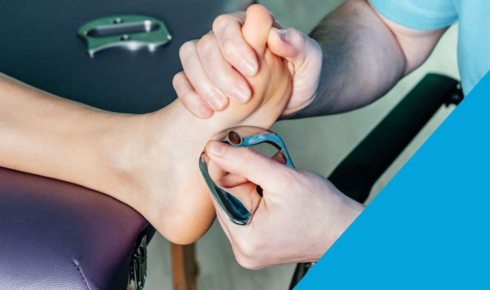How Targeted Massage and Therapy Accelerate Recovery from Plantar Fasciitis

Sharp pains in the heel can turn simple activities like walking or standing into a daily struggle. For many people, targeted massage and therapy bring measurable relief by addressing the root causes of plantar fasciitis rather than masking symptoms. Under the guidance of a skilled plantar fasciitis specialist, these treatments encourage natural healing, restore movement, and reduce flare-ups that often linger for months.
Focused Pressure Releases Tension Along the Plantar Band
The plantar fascia runs from the heel to the toes, supporting the foot’s arch with every step. Overuse, poor footwear, or repetitive strain can cause micro-tears and inflammation that tighten this thick band of tissue. Applying focused pressure through massage releases built-up tension and improves elasticity across the sole of the foot.
By pinpointing problem areas along the fascia, a plantar fasciitis doctor can use deep thumb or knuckle techniques to relax the fibers. This approach helps disperse tightness that radiates toward the heel and arch, easing discomfort without aggressive manipulation. Patients often feel a noticeable reduction in morning stiffness after several focused sessions.
Deep Tissue Work Improves Blood Flow to Damaged Fibers
Restricted circulation slows recovery by limiting oxygen and nutrient delivery to the injured fascia. Deep tissue work restores blood flow to the damaged layers, helping cells repair more efficiently. This method uses firm, deliberate strokes to reach connective tissues beneath the surface.
Unlike gentle massage, deep tissue therapy targets chronic inflammation hidden around the heel. A plantar fasciitis specialist may integrate slow, cross-fiber motions to break down congestion and stimulate new cell growth. The increased circulation not only speeds recovery but also prevents recurring inflammation that can develop from prolonged tension.
Gentle Stretching Restores Flexibility in Tight Foot Muscles
Therapeutic stretching complements massage by retraining the muscles that support the arch. Tight calves and intrinsic foot muscles often contribute to the strain placed on the plantar fascia. Gentle stretching restores length and flexibility, redistributing pressure more evenly across the foot.
A plantar fasciitis doctor often demonstrates low-impact stretches that involve gradual dorsiflexion—lifting the toes toward the shin—to reduce heel stress. Over time, these movements build resilience in the fascia and surrounding muscles, making each step more balanced and pain-free. Regular guided stretching can significantly shorten recovery time when combined with other treatments.
Trigger Point Therapy Eases Chronic Heel Stiffness
Trigger points are small, hyper-irritable knots within muscle tissue that can refer pain to the heel or arch. Targeted trigger point therapy applies sustained pressure to these areas to release muscular contractions and restore normal function. The approach is highly specific and requires precise anatomical knowledge of the lower leg and foot.
Under the care of a plantar fasciitis specialist, trigger point therapy reduces the secondary tension that often amplifies heel discomfort. This technique helps relax not only the fascia but also interconnected muscle groups like the soleus and gastrocnemius, which influence how weight is distributed during standing and walking.
Manual Manipulation Reduces Built-up Fascia Adhesions
Scar tissue can form as the fascia heals, binding layers of connective tissue together and limiting movement. Manual manipulation breaks down these adhesions, allowing the foot to flex naturally again. Techniques such as myofascial release and cross-fiber friction are applied slowly to soften dense areas and encourage tissue remodeling.
A plantar fasciitis doctor may combine manipulation with heat or soft tissue mobilization to enhance results. This multi-step process restores fluid movement within the fascia, helping patients regain smooth heel-to-toe motion. Over time, consistent manual therapy lessens the feeling of tightness that often persists even after pain subsides.
Consistent Massage Shortens Recovery Between Flare-ups
Plantar fasciitis can fluctuate, with periods of relief followed by painful recurrences. Consistent massage therapy reduces downtime between these flare-ups by maintaining flexibility and blood flow throughout the healing process. Regular treatments reinforce the body’s ability to manage inflammation naturally.
A plantar fasciitis specialist tracks progress over time, adjusting pressure and technique to match each stage of recovery. By addressing small areas of stiffness before they worsen, ongoing therapy minimizes tissue stress and prevents new micro-tears from forming. For many patients, this routine maintenance keeps symptoms from returning altogether.
Warm Therapy Softens Tissue for Better Mobility
Applying heat before or during massage loosens tight fascia fibers, making manual therapy more effective. Warm therapy increases circulation to the heel and arch, softening connective tissue and preparing it for deeper manipulation. It also soothes nerve sensitivity that often intensifies pain during initial treatments.
A plantar fasciitis doctor may recommend moist heat packs or controlled warm-water therapy sessions to prime the feet before hands-on care. This gentle preparation allows therapists to stretch and mobilize tissues without excessive discomfort, leading to smoother progress in mobility and flexibility.
Guided Foot Exercises Rebuild Stability After Pain Subsides
Once pain decreases, structured exercise becomes essential for restoring balance and preventing recurrence. Guided routines focus on strengthening the small stabilizing muscles in the foot and ankle that support the arch. This helps distribute body weight evenly and reduces strain on the plantar fascia during movement.
A plantar fasciitis specialist often includes towel curls, marble pickups, and resistance band work as part of rehabilitation. These controlled motions train the muscles to react properly under load, rebuilding stability and endurance. Consistent exercise, combined with ongoing therapy, provides the final step toward lasting relief and a full return to regular activity.
